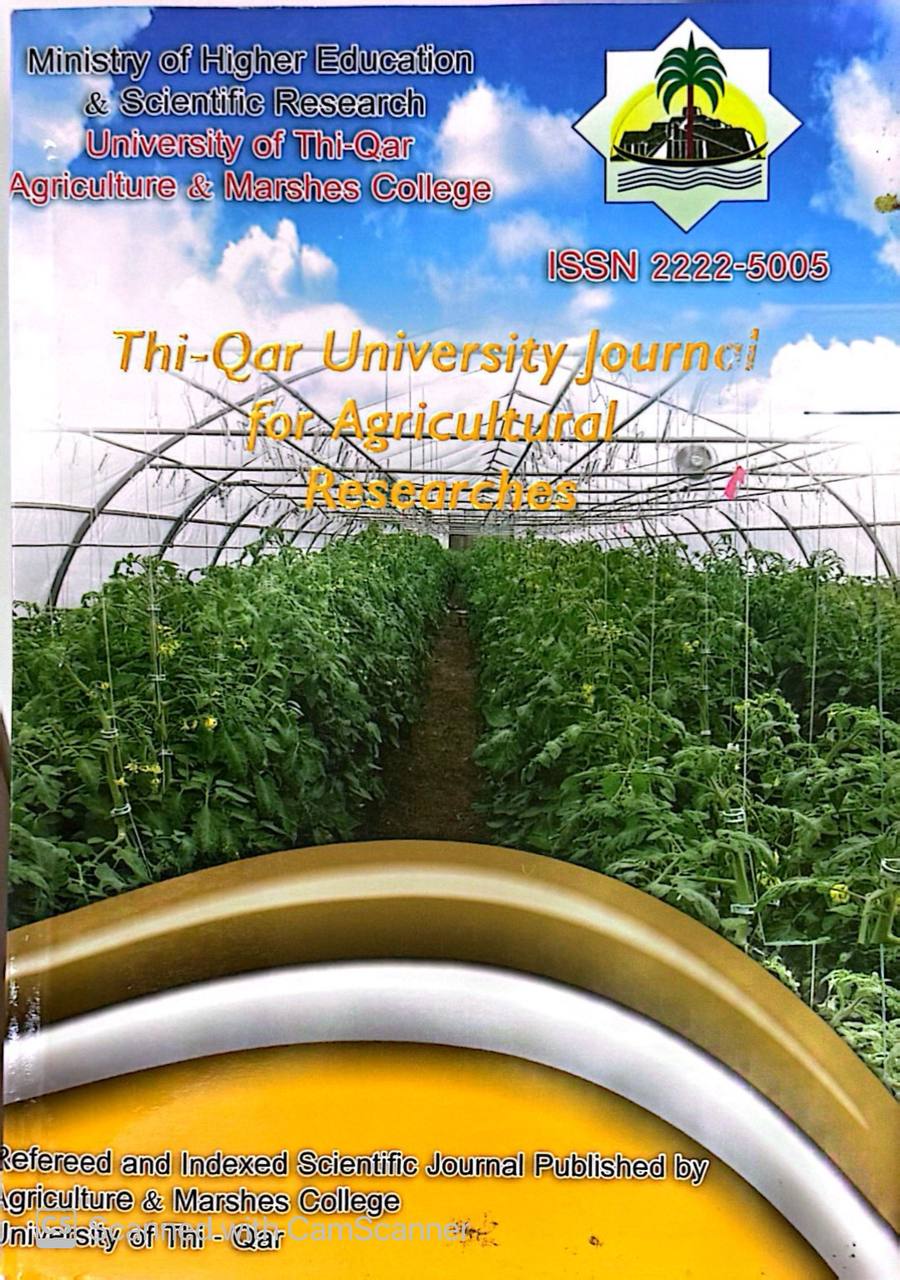Effect of Adding NPK-Chitosan Fertilizer and Organic Matter on phosphorus and potassium content of Corn (Zea mays L.)
DOI:
https://doi.org/10.54174/utjagr.v13i1.310Keywords:
Chitosan, wrapping, mixing, nutrient availability.Abstract
A field experiment was conducted at the College of Agriculture, University of Basrah's research station in Garmat Ali during 2022 agricultural season. The study aimed to investigate the impact of three types of fertilizers (commercial NPK as a control and two types of prepared NPK-Chitosan organic fertilizers) at four addition levels (0, 1, 1.5, and 2 ton ha-1) and two levels of organic matter (0% and 2.5%) on the availability of nitrogen and potassium in loam sandy soil and yield of corn (Zea mays L.).
The results indicated a significant effect of fertilizer type on increasing Phosphorus and Potassium Content of corn plant. The highest values of Phosphorus and Potassium Content for corn were 6.15 and 47.07 gm kg-1 respectively for the added fertilizer type. The NPK-Chitosan fertilizer in a 1:3 coating ratio achieved the, 3.62 and 31.01 kg ha-1, respectively, followed by the treatment of NPK-Chitosan fertilizer with a 1:3 mixing ratio and a fertilizer level of 2 tons/ha, which yielded The results showed a significant effect of fertilizer level on increasing Phosphorus and Potassium Content of the corn plants. Phosphorus and Potassium Content increased with higher levels of added fertilizer. The level 2 achieved the highest values of Phosphorus and Potassium Content for the vegetative part corn plants, reaching 2 tons per hectare.4.22 and 37.91 gm kg-1, and with a significant difference from level 1 and 1.5 tons per hectare, level 2 also outperformed level 0 tons per hectare (the control treatment). Similarly, the organic matter showed a significant effect the results indicated a significant interaction between the type and level of fertilizer, as well as the level of added organic matter to the soil, on Phosphorus and Potassium Content of the yellow corn plants. The NPK-Chitosan fertilizer with a 1:3 coating ratio added at the level of 2 tons per hectare outperformed the other treatments, yielding the highest phosphour contentand grain yield.
Downloads
References
Abdel-Aziz, H. M. M.; Hasaneen, M. N. A. and Omer, A. M. (2018). Foliar application of nano chitosan NPK fertilizer improves the yield of wheat plants grown on two different soils. Egypt. J. Exp. Biol., 14(1):63-72.
Agbodjato N., Noumavo P., Adjanohoun A., Agbessi L. and Baba-Moussa L. (2016). Synergistic Effects of plant growth promoting rhizobacteria and chitosan on in Vitro seeds germination, greenhouse growth, and nutrient uptake of maize (Zea mays L.), Biotechnology Research International.
Behboudi, F.; Tahmasebi-Sarvestani, Z.; Kassaee, M.Z.; Modarres-Sanavy, S.A.M.; Sorooshzadeh, A.; Mokhtassi-Bidgoli, A. (2019). Evaluation of Chitosan Nanoparticles Effects with Two Application Methods on Wheat under Drought Stress. J. Plant. Nutr. 2019, 42, 1439–1451. [CrossRef]
Black, C. A., D .D Evans. J.L.Whit., L E. Ensminger and F.E Clark.1965. Methods of soils analysis. Amer.Soc.of Agro. Inc. USA.
Choi, W.J., Chang, S.X., Jin, H.K., Jae, W.J., Sang, S.L., Yoon,K.S., and Choi, S.M.(2008). Nitrogen transformations and ammonia volatilization losses from 15N-urea as affected by the complication of composted pig manure. Soil Sci.87:485-493.
Jackson, M. L. 1958. Soil Chemical Analysis Prentic Hall. Inc. Englewood Cliffs, N. J. USA. P: 558.
Malerba M, Cerana R. (2018). Recent advances of chitosan applications in plants. Polymers 10:118. https://doi.org/10.3390/polym10020118
Mondale M., Malik M., Puteh A., Ismail M., Ashrafuzzaman M. and Naher L. (2012). "Effect of foliar application of chitosan on growth and yield in okra", Australian Journal of Crop Science, Vol. 6 No. 5, pp. 918–921.
Page, A. L., Miller, R. H. and D. R. Keeney. (1982). Methods of soil analysis. Part (2). 2nd. ed. Madison, Wisconsin, USA; PP: 1159.
Papanicolaou, E. P. (1976). Determination of cation exchange capacity of calcareous soils and their percent base saturation. Soil Sci., 121: 65 – 71.
Shao, C.X.; Hu, J.; Song, W.J.; Hu, W.M.(2005). Effects of seed priming with chitosan solutions of different acidity on seed germination and physiological characteristics of maize seedling. J. Zhejiang Univ. Agric. Life Sci. 1, 705–708.
Vince St D., Mesias, Anne Bernadette S. Agu , Precious Japheth L. Benablo1 Chun-Hu Chen, and David P. Penaloza Jr.(2019). Coated NPK Fertilizer Based on Citric Acid-Crosslinked Chitosan/Alginate Encapsulant. ournal of Ecological Engineering Volume 20, Issue 11, pages1–12.

Downloads
Published
Issue
Section
License
Copyright (c) 2024 Basam Mazhar Kazem, Haifa Jassim Hussein, Abdullah Abbas Hussein

This work is licensed under a Creative Commons Attribution-NonCommercial-ShareAlike 4.0 International License.







1.png)

